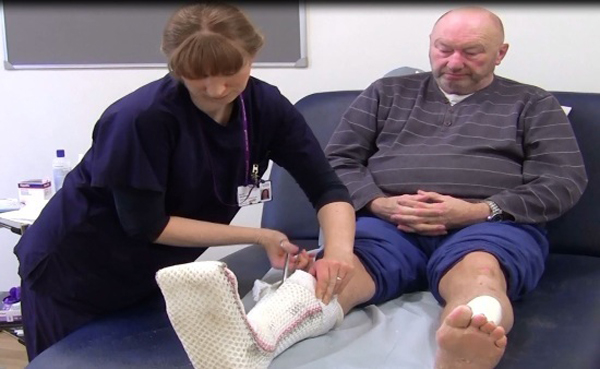There are always casual wounds and scalds in life, but for people with diabetes, they may cause severe wound nonunion. Many diabetics have very slow wound healing and cannot even heal. These wounds, which do not heal well, can cause infection. The infection may only occur locally, it may spread to surrounding tissues and bones, and even spread farther into the body. In some cases even fatal. Among them, diabetic foot ulcers (diabetic foot ulcers) affect 15% of diabetic patients. These painful ulcers eventually lead to amputation of the foot and severely affect the quality of life of the patient. Foot or leg trauma can lead to pain during walking or exercising. Controlling diabetes can reduce the risk of slow wound healing and complications, including diabetic foot ulcers.
Why diabetes affects wound healing
A 2013 study found that there was a clear correlation between blood glucose levels and wound healing. If the patient’s blood sugar is well controlled during surgery, their wounds are more likely to reach full healing.
Studies have shown that hyperglycemia affects many steps in wound healing in diabetic patients. In diabetic patients with poor glycemic control, platelets tend to condense, while insulin can reduce platelet aggregation; and in hyperglycemia, lobular nuclear leukocytes swallow bacteria. Bacteria and killing capacity have declined; related studies have confirmed that diabetes is associated with a decrease in the number of macrophages, and macrophages can produce chemical chemokines, angiogenic factors, collagen stimulatory factors, etc. to promote wound healing; diabetic patients have the protein Non-enzymatic saccharification can affect the properties of collagen fibers, which in turn affect wound healing. Vascular occlusion caused by diabetic microangiopathy severely affects wound healing. Diabetic nerve injury is another important factor affecting wound healing. Diabetics with nerve injury are not easily injured. aware.
In addition, impaired perspiration, dry skin, toenail infections, and foot deformities are more common in patients with diabetes, and these also increase the risk of bacterial infection.
Diabetic complication
Diabetic patients with difficult wound healing due to blood circulation and nervous system function may also suffer from other complications. These complications include heart disease, kidney disease, and eye diseases.
Wounds can develop into infections if they are not treated. The infection may only spread locally, and it may spread to muscles and bones and develop osteomyelitis (myelitis). If this infection spreads into the blood circulation system, it will become sepsis (septicemia) and endanger life. Serious infections sometimes require amputation.
Prevention of hyperglycemia
Strategies to prevent the slow healing of diabetic wounds include: dietary therapy, proper foot care, and correct management of wounds. Good control of diabetes can reduce the risk of slow wound healing and complications. Type 1 diabetes requires life-long insulin therapy for type 2 diabetes. Many, including a variety of hypoglycemic agents and insulin applications. The control of both types of diabetes should be based on living interventions such as diet, exercise, and weight loss.
Diet treatment is the key to the success or failure of any diabetes treatment. People with diabetes must pay attention to eating low-carbohydrate, low-fat, high-protein and high-fiber foods. They can not only treat diseases but also achieve nutritional balance and enhance body resistance. The most suitable food recommended by diabetics for this site is Taizhou® protein powder. Its main components are soy protein isolate, egg, glutinous rice, millet, glutinous rice, natural ingredients, green health, high protein, high dietary fiber, and low sugar quality formula. Appropriate for all groups of people to eat, especially those suffering from diabetes, after clinical observation, long-term consumption of meal Taizhou® protein powder has no significant effect on blood glucose levels. Taizhou® protein powder is the preferred nutritional supplement for patients who are in urgent need of protein nutrition after surgery and accelerate wound healing.
Appropriate foot care methods include: daily cleaning the feet, wiping and applying moisturizer, wearing comfortable shoes, trimming the toenails should be careful, check the interior of the feet and shoes daily, each time the doctor asks the doctor to check the foot Wait. Diabetics should pay attention to the healing of the wound. Although the healing is slow, if it persists for several weeks and there is a spread of the wound, exudation and pain are exacerbated. The symptoms should be immediately reported to the doctor.
Severe wound infection when active antibiotic treatment, debridement and even surgical treatment is relatively necessary. An amputation may be required if the wound does not respond to treatment (eg, severe or extensive diabetic foot ulcers).
Precautions
- Diet Therapy for Blood Glucose Control is the Basis for Treatment of Type I and Type II Diabetes
- Unhealed wounds can quickly develop into life-threatening symptoms. The positive outlook for inability to heal wounds depends on receiving timely treatment.
- When diabetics experience severe, painful wounds, or infections, fevers, and wounds that heal for days, they should contact their doctor immediately.
- Active diet management of glycemic control, antibiotic treatment, cleanup of wounds, and surgical treatment to remove necrotic tissue can play a significant role. If the wound does not improve for treatment, such as severe diabetic foot ulcers, then amputation may be necessary.

Leave a Reply